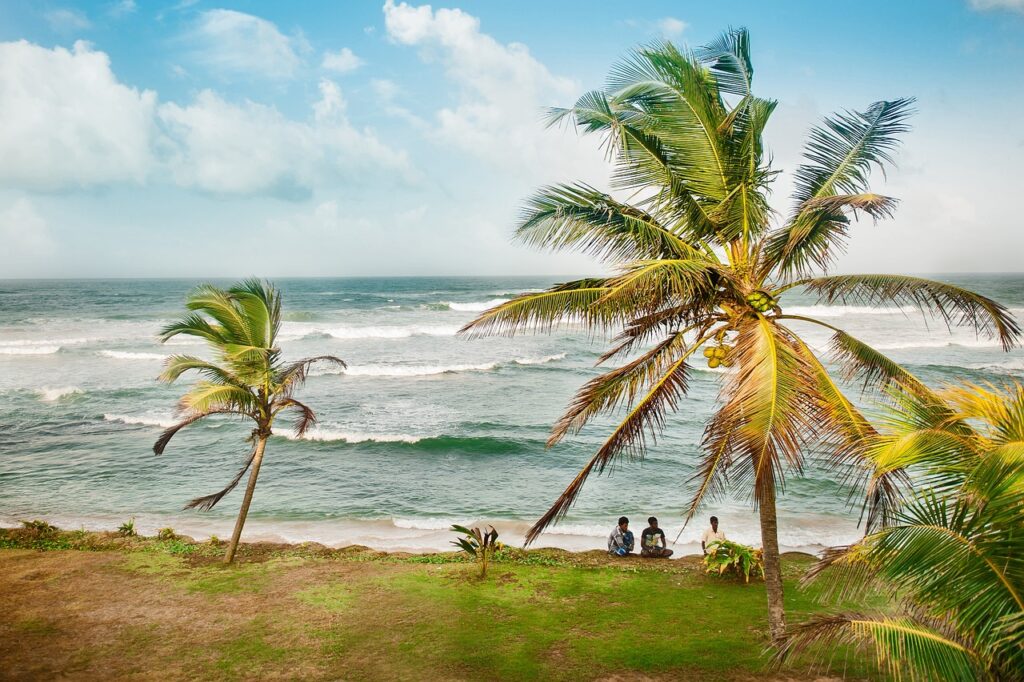This blog contains affiliate links. As part of afiiliate networks and as an Amazon Associate, I earn from qualifying purchases. If you make a purchase through these links, I may earn a small commission at no additional cost to you. I only recommend products and services that I believe in and have personally used or researched. Your support helps me continue to provide quality content—thank you!
A 2-week Sri Lanka itinerary lets you experience the country’s full diversity without rushing. Start in Colombo, then explore ancient sites in the Cultural Triangle, cool off in the misty Hill Country tea plantations, spot wildlife in Yala National Park, and conclude with beach relaxation in Mirissa or Trincomalee. December through March offers ideal weather for your journey through this compact island that packs UNESCO wonders, adventure activities, and culinary delights into every stop.
Brief overview of Sri Lanka as a destination
Nestled like a teardrop in the Indian Ocean, Sri Lanka packs an extraordinary range of experiences into a relatively compact island. This tropical paradise offers a perfect blend of cultural diversity, with influences from Sinhalese, Tamil, Moor, and colonial heritage evident in its architecture, customs, and vibrant festivals.
Sri Lanka—a teardrop island where diverse cultures and extraordinary experiences converge in tropical paradise.
You’ll be mesmerized by Sri Lanka’s scenic landscapes—from mist-shrouded tea plantations in the central highlands to pristine beaches along its 833-mile coastline.
The island’s historical sites include eight UNESCO World Heritage locations, with ancient cities like Anuradhapura and the rock fortress of Sigiriya telling tales of bygone kingdoms.
Adventure activities abound, whether you’re surfing in Arugam Bay, whale watching in Mirissa, or trekking through national parks.
Meanwhile, culinary delights await at every turn, with fragrant rice and curry dishes, fresh seafood, and exotic fruits tantalizing your taste buds.
Why two weeks is ideal for exploring Sri Lanka?
With such a wealth of experiences on offer, you’ll want to give Sri Lanka the time it deserves—and two weeks hits the sweet spot. This timeframe allows you to experience the country’s remarkable diversity without rushing through its treasures.
You’ll have enough days to explore ancient cities, lounge on pristine beaches, trek through misty highlands, and spot wildlife in national parks.
Two week adventures in Sri Lanka strike the perfect balance between seeing the major highlights and having breathing room in your travel itineraries. You can immerse yourself in cultural experiences like witnessing a traditional Kandyan dance performance or participating in a cooking class, while still enjoying downtime between destinations.
The exploration benefits of a fortnight are significant—you’ll avoid the exhaustion of cramming too much into too little time, while experiencing different regions and their distinct characters.
Sri Lanka may be compact, but its richness demands proper time.
Best seasons to visit and general travel tips
Though Sri Lanka enjoys a tropical climate year-round, timing your two-week adventure strategically can considerably enhance your experience. The island experiences two monsoon seasons affecting different regions: the southwest (May-September) and northeast (October-January). The best time to visit is typically December through March, when most of the country enjoys drier weather.
Avoid peak seasons (December-February) if you’re budget-conscious, as prices surge and popular sites become crowded. Consider shoulder seasons when planning—you’ll encounter fewer tourists while still enjoying favorable weather patterns.
Pack light, breathable clothing and always carry rain protection regardless of when you travel. Research local festivals that might coincide with your visit—Kandy’s Esala Perahera (July/August) offers spectacular cultural immersion.
Purchase a SIM card upon arrival for reliable connectivity, and always negotiate tuk-tuk prices before starting your journey.
Places to visit
Your two-week journey through Sri Lanka should include four distinct regions that showcase this island nation’s incredible diversity.
You’ll explore ancient ruins and sacred temples of the Cultural Triangle, wander through misty tea plantations in Hill Country, spot elephants and leopards in wildlife-rich National Parks, and unwind along pristine coastlines with turquoise waters.
Each area offers unique experiences that combine to create the perfect blend of culture, nature, adventure, and relaxation.
The Cultural Triangle
Located at the heart of Sri Lanka, the Cultural Triangle represents a treasure trove of ancient wonders that’ll transport you back in time. This region encompasses UNESCO-recognized Cultural Heritage sites including Sigiriya’s dramatic rock fortress, Polonnaruwa’s sprawling ruins, and Anuradhapura’s sacred bodhi tree.
Allow three to four days to explore these magnificent Historical Sites, where intricate Art and Architecture reveal the island’s sophisticated ancient civilization.
Between temple visits, sample Local Cuisine at small roadside eateries—don’t miss hoppers or spicy curry rice.
If your timing aligns, witness Traditional Festivals like Vesak or Poson Poya, when temples illuminate with colorful lanterns and devotees gather in celebration.
These vibrant ceremonies offer authentic glimpses into Sri Lanka’s living Buddhist traditions that continue to thrive within these ancient walls.
Hill Country & Tea Plantations
After exploring ancient ruins, Sri Lanka’s misty hill country offers a revitalizing change of scenery with its emerald tea plantations stretching as far as the eye can see.
Begin your highland adventure in Nuwara Eliya, Sri Lanka’s “Little England,” where you can experience authentic tea tasting at historic estates like Pedro’s.
Don’t miss the iconic train journey from Kandy to Ella, widely regarded as one of the world’s most scenic rail trips. The slow-paced ride gives you front-row views of cascading waterfalls and endless tea fields.
Once in Ella, tackle popular hiking trails to Little Adam’s Peak or Ella Rock for panoramic vistas.
Between adventures, savor local cuisine featuring fresh highland vegetables and browse artisan crafts in charming mountain towns, where skilled craftspeople create unique textiles and woodwork.
Wildlife & National Parks
Sri Lanka’s astonishing biodiversity awaits in three must-visit national parks, each offering distinctive wildlife encounters.
Yala National Park boasts the highest leopard density worldwide, where safari experiences reveal these majestic cats alongside sloth bears and crocodiles.
At Udawalawe, you’ll witness herds of wild elephants roaming freely—a stark contrast to the ethical elephant sanctuaries nearby where rehabilitation efforts protect orphaned calves.
Minneriya’s spectacular “The Gathering” features hundreds of elephants congregating around the ancient tank during dry season.
Bundala National Park delivers premier bird watching opportunities with 197 species, including vibrant flamingos and endemic Sri Lankan junglefowl.
Don’t miss Mirissa’s coastline for marine biodiversity experiences—blue whale watching and turtle conservation efforts provide unforgettable encounters with these magnificent creatures in their natural habitat.
Coastal Experiences
With coastlines spanning over 1,600 kilometers, Sri Lanka’s sun-soaked beaches offer spectacular diversity for every type of traveler. Dedicate 3-4 days of your itinerary to explore premier beach destinations like Mirissa, Unawatuna, and Trincomalee.
Catch waves at Arugam Bay, one of Asia’s top surfing spots during May-September, or try Weligama for gentler breaks perfect for beginners.
Between swimming sessions, sample local cuisine at beachfront shacks—freshly caught fish curries and coconut sambol are unmissable.
Don’t overlook coastal wildlife tours; blue whale watching off Mirissa (December-April) delivers unforgettable encounters.
End your beach days with breathtaking sunset views at Galle Fort’s ramparts or from a catamaran cruise along Bentota’s golden shoreline.
Best Sri Lanka 2-Week Itinerary
Perfectly crafted for adventurous souls seeking both cultural immersion and natural beauty, this 14-day Sri Lanka Encompassed journey delivers an ideal balance of guided exploration and personal discovery.
You’ll begin in bustling Colombo before venturing to ancient wonders like Dambulla’s cave temples and the imposing Sigiriya rock fortress.
Wind through the misty Knuckles Mountain Range to Kandy’s revered Temple of the Tooth. Experience authentic village life, master local cuisine during cooking demonstrations, and journey through emerald tea plantations.
The adventure continues with a scenic train ride, wildlife safari in Yala National Park, and concludes with beach relaxation in Mirissa and historic exploration in Galle.
Best For: Travelers seeking a comprehensive Sri Lankan experience with a mix of cultural sites, natural beauty, and beach time who prefer a structured small-group tour with some free time built in.
This itinerary:
- Covers major highlights across Sri Lanka with a balanced pace and light physical requirements, making it accessible for most fitness levels
- Small group size (max 15) ensures personalized attention while still providing social interaction opportunities
- Includes authentic local experiences like village visits, cooking demonstrations, and a mix of accommodations with character
Practical Planning Information
Before commencing your Sri Lankan adventure, you’ll need to address some practical matters including visa requirements, budget considerations, cultural protocols, and packing essentials.
Understanding the island’s distinct climate patterns will help you choose the prime time to visit, potentially avoiding monsoon seasons in certain regions.
These practical planning elements will guarantee your two-week journey flows smoothly while respecting local customs and maximizing your travel experience.
Visa Information
Most travelers visiting Sri Lanka need to obtain an Electronic Travel Authorization (ETA) before their arrival, which functions as a short-term visa for tourists.
You’ll find the visa application process straightforward through the official Department of Immigration website. Standard visa processing takes 24-48 hours, though urgent approvals are available for an additional fee.
The standard tourist ETA costs $35 USD for most nationalities and grants a visa duration of 30 days, which can be extended up to 9 months during your stay.
Visa requirements include a passport valid for at least six months beyond your arrival date, proof of onward travel, and sufficient funds for your stay.
Remember to apply at least three days before your journey to avoid any last-minute complications.
Estimated costs and budget tips
A two-week journey through Sri Lanka typically costs on average between $800-$1,500 USD per person, depending on your travel style.
Budget accommodation in guesthouses or hostels runs $10-25 per night, while mid-range hotels cost $30-60.
Local transportation is incredibly affordable—tuk-tuks charge $1-5 per ride, while train journeys between major cities rarely exceed $10 for second class.
Food costs remain reasonable throughout the island, with street food meals available for $1-3 and restaurant dining ranging from $5-15.
Factor in entry fees for cultural sites ($10-30 each) and wildlife parks ($15-40), which can add up quickly.
Don’t skimp on travel insurance, which typically costs $30-60 for extensive coverage.
Save money by eating where locals do and traveling during shoulder season (April-June, September-November).
Cultural etiquette and customs
When visiting Sri Lanka, understanding local customs will greatly enhance your experience and show respect for the island’s rich cultural heritage.
Always remove shoes before entering temples, and cover shoulders and knees when visiting religious sites. Women should avoid touching male Buddhist monks or handing items directly to them. In a public transportation, it is appropriate only for man to sit next to a male monk and females next to a female monk.
Never turn your back to Lord Budha statue or other deities, and do not take any selfies.
Sri Lankan dining practices involve eating with your right hand only, though restaurants frequented by tourists typically provide utensils.
When invited to a local home, bring a small gift and wait to be seated before eating.
Public displays of affection are frowned upon, while modest dress codes apply, especially outside tourist areas.
If you’re bathing in a river in the countryside, it’s best to avoid swimsuits and bikinis. Instead, opt for shorts or leggings paired with a t-shirt. Sri Lankans are generally tolerant of foreigners, but dressing modestly shows cultural awareness and respect.
Additionally, always check the depth and current before entering the water, as some rivers can be deceptively strong. If you’re in a remote area, it’s a good idea to ask locals about safe spots for swimming.
I’ve often seen foreigners entering banks in Sri Lanka wearing shorts, crop tops, or beachwear. This isn’t appropriate—just as you likely wouldn’t visit a bank dressed like that in your own country. While Sri Lankans are generally very tolerant, it’s important to respect institutions and adhere to basic decorum.
Dressing modestly in public spaces like banks, government offices, and temples shows respect for local customs. Opt for casual but appropriate attire, such as long pants, skirts, or a modest top. Just because people are accommodating doesn’t mean cultural norms should be disregarded. Being mindful of how you present yourself fosters positive interactions and demonstrates appreciation for the local way of life.
Learn these cultural customs, and locals will appreciate your efforts.
Packing essentials for different regions
Packing for Sri Lanka requires thoughtful consideration as the island’s varied regions demand different clothing and gear. For the humid coastal areas, pack lightweight, breathable fabrics, swimwear, and sun protection.
The central highlands call for light layers including a rain jacket and sweater for cool evenings, especially in Nuwara Eliya. When visiting ancient cities and religious sites, bring modest clothing covering shoulders and knees.
Essential gear includes a quality daypack, reusable water bottle, and comfortable walking shoes for temple explorations. Weather considerations should guide your choices—pack quick-dry clothing for the monsoon seasons and moisture-wicking fabrics year-round.
Don’t forget travel gadgets like a universal adapter, portable charger, and headlamp for unexpected power outages. A microfiber towel and insect repellent will serve you well everywhere.
Best time to visit
The best time to visit Sri Lanka largely depends on which regions you’ll explore, as the island experiences two distinct monsoon seasons affecting different parts of the country.
For southern and western coasts, December through April offers sunny weather and ideal beach conditions, while the east coast shines from May to September.
Peak tourism occurs during December-January, driving prices higher and creating crowds at popular sites. Consider shoulder seasons (April-May or September-October) for better travel deals and fewer tourists while still enjoying favorable weather patterns.
Cultural festivals add vibrant dimensions to your trip—plan around Vesak (May) to witness illuminated streets celebrating Buddha’s birth, or Esala Perahera (July-August) in Kandy featuring spectacular elephant parades.
Match your itinerary with seasonal highlights for the most rewarding Sri Lankan experience.
Why Sri Lanka offers something for every traveler?
Despite its modest size, Sri Lanka stands as a traveler’s paradise that defies simple categorization. This teardrop-shaped island packs extraordinary cultural diversity within its compact borders, from ancient Buddhist temples to colonial fortresses spanning Portuguese, Dutch, and British influence.
You’ll find adventure activities for every adrenaline level—surf world-class breaks along the southern coast, trek misty mountain trails in the central highlands, or spot leopards on safari in national parks.
The local cuisine dazzles with its bold spices and fresh seafood, offering everything from street food to sophisticated curry feasts.
History buffs will marvel at UNESCO-listed historical landmarks like Sigiriya’s ancient rock fortress and the sacred Temple of the Tooth. If relaxation is your priority, wellness retreats flourish in serene settings, offering traditional Ayurvedic treatments that have been perfected over centuries.
Whatever your travel style, Sri Lanka delivers unforgettable experiences.
Frequently Asked Questions
Is Wi-Fi Reliable Throughout Sri Lanka?
Wi-Fi availability varies across Sri Lanka. You’ll find decent connectivity options in cities, best cafes offer reliable networks, but consider purchasing mobile data for remote working in rural areas.
How Safe Is Sri Lanka for Solo Female Travelers?
You’ll find Sri Lanka generally safe for solo female travel. Respect cultural norms, dress modestly, and maintain confident local interactions. Keep emergency contacts handy and follow basic safety tips like avoiding late-night walks alone.
What Vaccination Requirements Exist for Entering Sri Lanka?
You’ll need standard vaccinations for Sri Lanka’s entry requirements. Consider typhoid and hepatitis A shots too. While health insurance isn’t mandatory, it’s wise during disease outbreaks. Travel restrictions may change unexpectedly.
Are Credit Cards Widely Accepted or Is Cash Necessary?
Credit cards are accepted in tourist hubs, but you’ll need local currency for authentic experiences. Travelers report card limitations in rural areas, so always carry cash alternatives for your adventurous Sri Lankan journey.
What Voltage/Plug Adapters Will I Need for My Electronics?
You’ll need adapters for Type D, M, or G plugs. Sri Lanka uses 230V with 50Hz frequency. Bring universal power adapters to guarantee your devices remain compatible throughout your electrifying adventure.
Conclusion
You’ll find Sri Lanka’s magic lingers long after you’ve left its shores. With treasured memories of misty tea plantations, ancient ruins, and golden beaches, you’ve experienced the island’s remarkable diversity in just two weeks. Whether you’ve tracked leopards in Yala, surfed Arugam Bay’s perfect waves, or simply savored a fresh coconut at sunset, Sri Lanka’s warmth will call you back again.

Erzsebet Frey (Eli Frey) is an ecologist and online entrepreneur with a Master of Science in Ecology from the University of Belgrade. Originally from Serbia, she has lived in Sri Lanka since 2017. Eli has worked internationally in countries like Oman, Brazil, Germany, and Sri Lanka. In 2018, she expanded into SEO and blogging, completing courses from UC Davis and Edinburgh. Eli has founded multiple websites focused on biology, ecology, environmental science, sustainable and simple living, and outdoor activities. She enjoys creating nature and simple living videos on YouTube and participates in speleology, diving, and hiking.
🌿 Explore the Wild Side!
Discover eBooks, guides, templates and stylish wildlife-themed T-shirts, notebooks, scrunchies, bandanas, and tote bags. Perfect for nature lovers and wildlife enthusiasts!
Visit My Shop →
